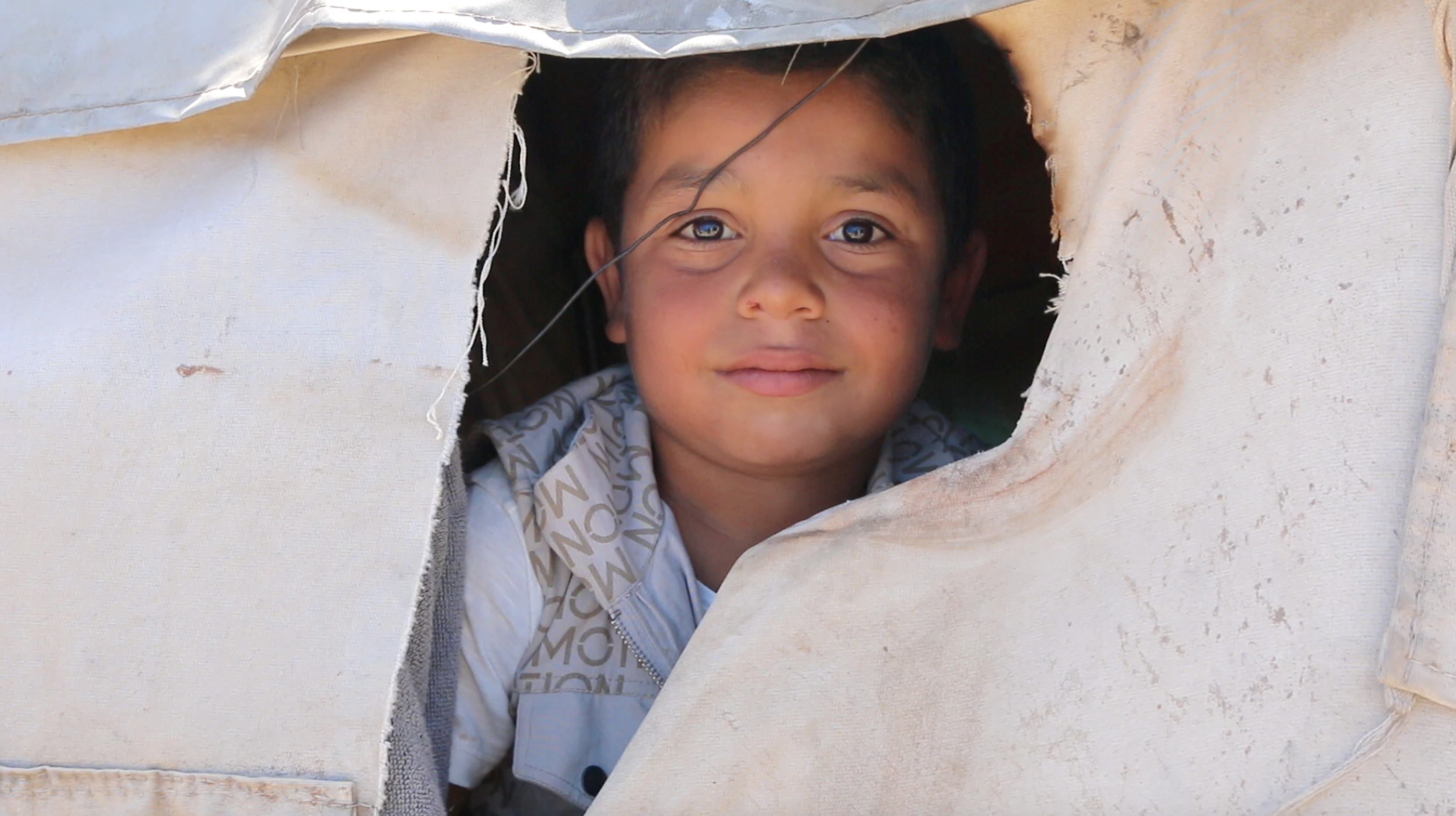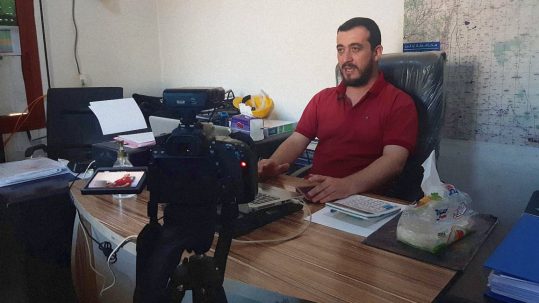Through The Lens Of Crisis: COVID-19 And The People On The Frontlines Of Conflict
COVID-19 Risks Catastrophe in Vulnerable Idlib
June 19, 2020
COVID-19 Risks Catastrophe in Vulnerable Idlib
“After losing everything, we simply have no energy left to fight the disease,” said an 11 year-old boy in a displacement camp in Idlib, Syria.
The Soufan Center heard firsthand from multiple displaced persons, healthcare workers, and humanitarian organizations in Idlib, Syria about prevention efforts related to a potential COVID-19 outbreak, using Truepic’s image verification platform to record select images and interviews and help ensure accuracy and veracity of reporting. The interviews took place from late May to early June.
Abdul-Hadi Mustafa Al-Sayyed, 34, described his family’s challenges over recent months and his concerns about a looming COVID-19 outbreak.
“We were displaced several times [from violence]. We would flee our home then come back, only to leave again afterwards because of more bombings,” Al-Sayeed said. Al-Sayeed moved to a displacement camp from his home in Maarat al-Numan.
Al-Sayyed spoke to us from Al-Mazar Camp in Barisha, a village outside of Idlib.
“We should wear masks, but we don’t have masks, so they suggested that we put diapers on our noses.”
Al-Mazar camp houses nearly 700 people. Interviewees reported overcrowded tents, and no masks or protective equipment in the camp.
IDLIB: Where Crisis is the Norm
After more than nine years, the Assad regime, backed by Russia and Iran, continues to encroach upon territory in northwest Syria they lost over the course of the war. The Islamic State is exploiting the conditions to regroup while a range of non-state actors continue to conduct attacks regularly. Meanwhile, the Syrian currency has plummeted, exacerbating the crisis and causing further economic misery.
These factors have led to a humanitarian and security crisis in Idlib of devastating proportions, — from displacement and malnutrition to terrorism. According to the UN Refugee Agency’s latest Global Trends report, more than 13.2 million people have been forced to flee their home in Syria as of December 2019.
COVID-19: Limited Humanitarian Assistance Could Mean Catastrophe
As of June 14, the Syrian Ministry of Health confirmed 177 cases of COVID-19, with the majority of cases in Homs and Damascus. The comparatively low number of cases very likely reflects the lower number of tests and testing capacity. Local journalists have raised concerns about the transparency of the Assad regime around the number of cases.
Pre-COVID-19, humanitarian needs in northwest Syria were already largely unmet. According to a UN report issued June 12, an estimated 2.8 million people are in need of humanitarian assistance in the northwest of the country. Geopolitics have complicated matters in Syria. For example, in January, the UN Security Council adopted a resolution to reduce cross-border humanitarian aid from four crossing points to two, following pressure from Russia.
Some local and international humanitarian organizations have been working to prevent the spread of the virus. There is particular fear around COVID-19 spreading from the Turkish border and lack of testing capacity in Kurdish-controlled areas in northwest Syria. Hundreds of thousands live in crowded tents with family members and without reliable information on how to prevent the spread of the virus.
The White Helmets Civil Defense Force, a local humanitarian volunteer organization, is among the most active in trying to prevent the spread of coronavirus.
A member of the White Helmets told The Soufan Center’s reporting team that they were disinfecting key facilities and conducting education campaigns, through an initiative in collaboration with other local aid agencies in northern Syria dubbed “Volunteers Against the Coronavirus.” The World Health Organization, the UN Office for the Coordination of Humanitarian Affairs, and the Islamic Relief are providing some aid, but the needs remain acute.
According to UN statistics, as of June 1, approximately 840,000 of the 1 million people in Syria who fled from their homes in the first part of the year have not returned, which includes more than half a million children and 180,000 women.
“We heard about this virus. No one gave us anything, and now, we’re worried what will happen if (our children) become infected,” Abdul-Hadi Musatafa Al-Sayyed said. “We’re keeping our children and our tents clean. That’s the only thing we can do. It is as if we’re not humans.”
Rumors were swirling around the Al-Mazar camp about the virus. For instance, several displaced persons said that they were eating onions and garlic in an attempt to ward off the virus. Social distancing is impossible because of overcrowded tents.
Dilapidated Health Infrastructure Leaves Idlib Vulnerable to Health Shocks
Medecins Sans Frontieres (MSF or Doctors without Borders) warned that the region is unprepared to cope with the pandemic and has called on Turkey to allow the urgent transit of essential supplies and humanitarian staff access into northwestern Syria. “Our incapacity to scale up our activities in Idlib and do more in the face of this health emergency is a daily reality and could have dramatic consequences,” warned Cristian Reynders, MSF Field Coordination in Northwest Syria.
The equipment and doctors required to treat the population in the event of a COVID-19 outbreak is extremely limited. As of early June, Idlib’s Health Directorate said there are only 600 doctors, 3,065 hospital beds, and 205 intensive care beds for an estimated population of 4.1 million people, slightly larger than the population of Los Angeles, CA. This is the equivalent of one doctor per 6,800 people and one bed in intensive care for every 20,000 people. “In Idlib, there is one diagnostic center where these [diagnostic] kits are used to test COVID-19 suspected cases, but kits are not available in sufficient numbers,” said Dr. Iyad Raadoun from the Syria Medical Coordinator of the WATAN Foundation in Idlib.
“There is a shortage of ventilators as we only have around 100 of them in healthcare centers,” he said.
The damage to health infrastructure alongside the ongoing movement of people due to the conflict will only increase the risk of COVID-19 spreading in the camps. While, as of this writing, no positive COVID-19 cases have been confirmed in Idlib by medical facilities, patients have shown symptoms of the virus, and the capacity to test and trace people for the virus is extremely low.
A Failure to Act Now Will Have Severe Consequences
The recent arrival of the coronavirus in Syria is expected to further destabilize the already war-torn country. Experts say that the IDP camps in particular are ripe for the spread of COVID-19. A failure to prevent a COVID-19 outbreak is likely to strengthen terrorist groups’ recruitment and popular support in Idlib. And as the United States continues to distance itself from its role in Syria, Russia and Turkey eagerly fill the void. The failure of the international community to act – both to prevent, protect, and support Syrians before the situation worsens, and take the necessary steps for a political process to take shape, will have dire consequences. A COVID-19 outbreak in Syria will compound the effects of nearly a decade of conflict, displacement, and devastation.
Reporting from Idlib by Mustafa Dahnon and Fared Alhor, Writing by James Blake
In the News






